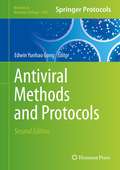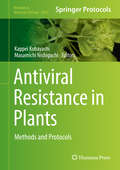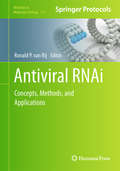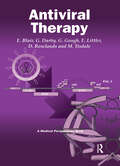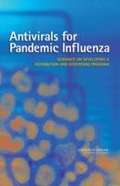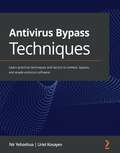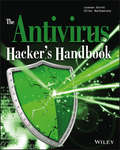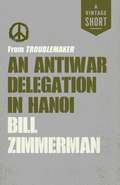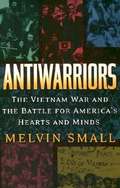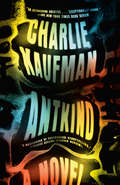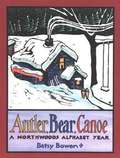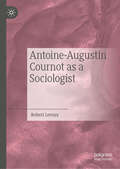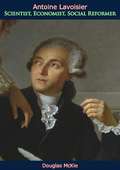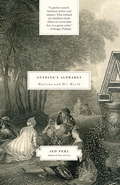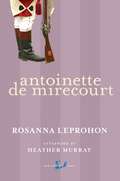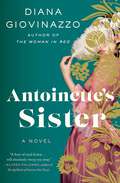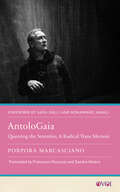- Table View
- List View
Antiviral Methods and Protocols (Methods in Molecular Biology #1030)
by Edwin Yunhao GongAlthough antiviral drugs have been successfully developed for some viral diseases, there remains a clear, unmet medical need to develop novel antiviral agents for the control and management of many viruses that currently have no or limited treatment options as well as a need to overcome the limitations associated with the existing antiviral drugs, such as adverse effects and emergence of drug-resistant mutations. The second edition of Antiviral Methods and Protocols features: All chapters are new and written by experts in the field, reflecting the major recent technical advances in antiviral research and discovery. This edition focuses on many important human viruses, such as human immunodeficiency virus type 1 (HIV-1), hepatitis viruses (hepatitis B and C viruses), herpes viruses, human respiratory syncytial virus (RSV), and influenza virus, while also featuring some important emerging viruses, such as dengue virus, West Nile virus, and chikungunya virus. As a volume in the highly successful Methods in Molecular Biology series, chapters include introductions to their respective topics, lists of the necessary materials and reagents, step-by-step, readily reproducible laboratory protocols, and tips on troubleshooting and avoiding known pitfalls. Comprehensive and cutting-edge, Antiviral Methods and Protocols, Second Edition will serve as an excellent laboratory reference for pharmaceutical and academic biologists, medicinal chemists, and pharmacologists as well as for virologists in the field of antiviral research and drug discovery.
Antiviral Methods and Protocols (Methods in Molecular Medicine #24)
by Raymond F. Schinazi Derek KinchingtonExperienced scientists describe-in an easily-followed format-their state-of-the-art techniques for evaluating antiviral compounds. The assays described include systems for investigating drugs used against herpesviruses, hepatitis viruses, human immunodeficiency viruses, human papillomaviruses, and influenza viruses. These well-tested methods range from cellular assays to some of the most up-to-date molecular approaches for identifying compounds that are active against viral enzymes and the development of viral resistance against drugs currently in use. Timely and comprehensive, Antiviral Methods and Protocols offers today's researchers in academia, clinical departments, and the pharmaceutical industry the powerful, reproducible, and novel methods needed to evaluate compounds effective against both acute and chronic infections.
Antiviral Resistance in Plants: Methods and Protocols (Methods in Molecular Biology #2028)
by Kappei Kobayashi Masamichi NishiguchiThis detailed book explores strategies that have been developed to combat plant virus infection. Beginning with a section on techniques for identifying and studying the virus resistance gene involved in plant innate immunity, the volume continues by delving into techniques related to novel mechanisms of plant virus resistance, methods for the analysis and practical use of RNA silencing, as well as methods for the development of plant viral vaccines. Written for the highly successful Methods in Molecular Biology series, chapters include introductions to their respective topics, lists of the necessary materials and reagents, step-by-step, readily reproducible laboratory protocols, and tips on troubleshooting and avoiding known pitfalls. Authoritative and practical, Antiviral Resistance in Plants: Methods and Protocols serves as an ideal guide for researchers working to combat the serious threats plant virus diseases represent for agricultural production and beyond.
Antiviral Resistance in Plants: Methods and Protocols (Methods in Molecular Biology #894)
by John M. Watson Ming-Bo WangStudies related to pathogen-mediated virus resistance in plants were instrumental in providing some of the historical observations which ultimately led to the vital discovery of double-stranded RNA (dsRNA)-induced gene silencing or RNA interference (RNAi), which has since revolutionized research on plant-virus interactions. In Antiviral Resistance in Plants: Methods and Protocols, expert researchers in the field detail many of the methods which are now commonly used to study the phenomenon of RNA silencing in relation to viral infections of plants. These include methods and techniques for the isolation and quantitative/qualitative analyses of plant small 21-24 nucleotide RNAs such as small interfering RNAs (siRNAs) and microRNAs (miRNAs) as well as the analysis and manipulation of virus-induced gene silencing (VIGS) in both monocotyledonous and dicotyledenous plants and the use of hairpin RNA (hpRNA) transgenes. Written in the highly successful Methods in Molecular BiologyTM series format, chapters include introductions to their respective topics, lists of the necessary materials and reagents, step-by-step, readily reproducible laboratory protocols, and key tips on troubleshooting and avoiding known pitfalls. Authoritative and practical, Antiviral Resistance in Plants: Methods and Protocols seeks to aid scientists in the further study of this crucially important botanical trait.
Antiviral RNAi: Concepts, Methods, and Applications (Methods in Molecular Biology #721)
by Ronald P. RijViruses and RNAi share an intricate relationship at many levels. RNAi is an important antiviral defense mechanism in plants and invertebrates, microRNAs - of viral or cellular origin - affect many aspects of virus biology, and replication of many, if not all, mammalian viruses can be suppressed by RNAi. Antiviral RNAi: Concepts, Methods, and Applications provides a collection of protocols for the analysis of viral small RNAs and natural antiviral RNAi responses as well as for the development and optimization of RNAi-based antiviral drugs. As RNAi is a central regulatory mechanism in the cell, the methods in this volume can also be applied out of the context of a virus infection. Divided into five convenient parts, this detailed volume reviews important basic concepts in the field of antiviral RNAi, provides experimental and bio-informatic tools for the analysis of small silencing RNAs, covers methods to biochemically dissect RNAi-based antiviral defense and viral counter-defense mechanisms, describes methods for the design, expression, and delivery of therapeutic antiviral siRNAs, and finally presents genome-wide RNAi approaches for the identification of factors involved in virus replication. Written in the highly successful Methods in Molecular BiologyTM series format, chapters contain introductions to their respective topics, lists of the necessary materials and reagents, step-by-step, readily reproducible laboratory protocols, and notes on troubleshooting and avoiding known pitfalls. Authoritative and accessible, Antiviral RNAi: Concepts, Methods, and Applications serves as an ideal guide for both novice and experienced researchers alike striving to dissect the role of RNAi in the viral life cycle or to further boost the development of novel therapeutics and experimental tools based on RNAi technology.
Antiviral Therapy
by Dr Eddie Blair Dr Graham Darby Dr Gerlad Gough Dr Eddie Littler Prof D Rowlands Dr Margaret TisdaleA concise summary of vital information on drug targets and current therapy regimes for all of the major viral infections. The book brings together in a single volume aspects of antiviral therapy from diverse areas of research and practice, providing up-to-date coverage of recent developments. Starting from an overview of the history of antiviral chemotherapy, the book goes on to describe the development of drugs against HIV, herpesvirus, respiratory viruses, papillomaviruses and hepatitis virus infections. The drugs currently available are reviewed and possible therapies and drug targets for future prophylactic and therapeutic use are discussed.
Antivirals for Pandemic Influenza: GUIDANCE ON DEVELOPING A DISTRIBUTION AND DISPENSING PROGRAM
by Institute of Medicine of the National AcademiesPlanning for an influenza pandemic, whether it occurs in the near or distant future, will need to take into account many constantly evolving factors. The Institute of Medicine (IOM) Committee on Implementation of Antiviral Medication Strategies for an Influenza Pandemic was asked by the Department of Health and Human Services, (DHHS) to consider best practices and policies for providing antiviral treatment and prophylaxis during a pandemic event. The committee’s report, entitled Antivirals for Pandemic Influenza: Guidance on Developing a Distribution and Dispensing Program, calls for a national and public process of creating an ethical framework for antiviral use within the context of uncertainty and scarcity. It is unclear whether antivirals will work against a pandemic strain as well as they work against seasonal influenza. Also, government stockpiles may not be sufficient for all possible uses in part because antivirals are costly and public health agencies must invest in other important activities, including other medical resources for pandemic influenza. Furthermore, the report identifies the lack of a science-based advisory body to guide decision making during the pandemic, including guidance on all dimensions of antiviral dispensing (for example, prioritization, drug safety, and antiviral resistance). The report also acknowledges the need for diverse methods and sites of dispensing, and discusses their advantages and disadvantages.
Antivirus Bypass Techniques: Learn practical techniques and tactics to combat, bypass, and evade antivirus software
by Nir Yehoshua Uriel KosayevDevelop more secure and effective antivirus solutions by leveraging antivirus bypass techniquesKey FeaturesGain a clear understanding of the security landscape and research approaches to bypass antivirus softwareBecome well-versed with practical techniques to bypass antivirus solutionsDiscover best practices to develop robust antivirus solutionsBook DescriptionAntivirus software is built to detect, prevent, and remove malware from systems, but this does not guarantee the security of your antivirus solution as certain changes can trick the antivirus and pose a risk for users. This book will help you to gain a basic understanding of antivirus software and take you through a series of antivirus bypass techniques that will enable you to bypass antivirus solutions. The book starts by introducing you to the cybersecurity landscape, focusing on cyber threats, malware, and more. You will learn how to collect leads to research antivirus and explore the two common bypass approaches used by the authors. Once you've covered the essentials of antivirus research and bypassing, you'll get hands-on with bypassing antivirus software using obfuscation, encryption, packing, PowerShell, and more. Toward the end, the book covers security improvement recommendations, useful for both antivirus vendors as well as for developers to help strengthen the security and malware detection capabilities of antivirus software. By the end of this security book, you'll have a better understanding of antivirus software and be able to confidently bypass antivirus software.What you will learnExplore the security landscape and get to grips with the fundamentals of antivirus softwareDiscover how to gather AV bypass research leads using malware analysis toolsUnderstand the two commonly used antivirus bypass approachesFind out how to bypass static and dynamic antivirus enginesUnderstand and implement bypass techniques in real-world scenariosLeverage best practices and recommendations for implementing antivirus solutionsWho this book is forThis book is for security researchers, malware analysts, reverse engineers, pentesters, antivirus vendors looking to strengthen their detection capabilities, antivirus users and companies that want to test and evaluate their antivirus software, organizations that want to test and evaluate antivirus software before purchase or acquisition, and tech-savvy individuals who want to learn new topics.
The Antivirus Hacker's Handbook
by Elias Bachaalany Joxean KoretThe book focusses on how to reverse engineer antivirus software, detect vulnerabilities and exploit them. This knowledge can benefit both an attacker (legal or otherwise, as happens with any kind of knowledge) as well as antivirus software vendors. It's composed of the following sections: Reverse engineering antivirus software Antivirus software evasion Attacking antivirus software Exploiting antivirus software Conclusions about current state-of-the-art of antivirus software Recommendations to both users and vendors
An Antiwar Delegation in Hanoi: from Troublemaker
by Bill ZimmermanBill Zimmerman put his life at risk for the greater social good when he smuggled medicines to the front lines in North Vietnam and spent time filming in Hanoi under U.S. bombardment. In his extraordinary political memoir, he takes us into the hearts and minds of those making the social revolution of the sixties. Zimmerman—who crossed paths with political organizers and activists like Abbie Hoffman, Daniel Ellsberg, César Chávez, Jane Fonda, and Tom Hayden—captures a groundbreaking zeitgeist that irrevocably changed the world as we knew it.A Vintage Shorts Vietnam Selection. An ebook short.
Antiwarriors: The Vietnam War and the Battle for America's Hearts and Minds
by Melvin SmallThe antiwar movement comes to life in this compelling new book that is sure to fascinate all those interested in the Vietnam War and the turbulent, tumultuous 1960s.
Antkind: A Novel
by Charlie KaufmanThe bold and boundlessly original debut novel from the Oscar®-winning screenwriter of Being John Malkovich, Adaptation, Eternal Sunshine of the Spotless Mind, and Synecdoche, New York.&“A terrific debut novel that makes Gravity&’s Rainbow read like a Dr. Seuss story . . . a masterwork of postmodern storytelling.&”—Kirkus Reviews (starred review) B. Rosenberger Rosenberg, neurotic and underappreciated film critic (failed academic, filmmaker, paramour, shoe salesman who sleeps in a sock drawer), stumbles upon a hitherto unseen film made by an enigmatic outsider—a film he&’s convinced will change his career trajectory and rock the world of cinema to its core. His hands on what is possibly the greatest movie ever made—a three-month-long stop-motion masterpiece that took its reclusive auteur ninety years to complete—B. knows that it is his mission to show it to the rest of humanity. The only problem: The film is destroyed, leaving him the sole witness to its inadvertently ephemeral genius. All that&’s left of this work of art is a single frame from which B. must somehow attempt to recall the film that just might be the last great hope of civilization. Thus begins a mind-boggling journey through the hilarious nightmarescape of a psyche as lushly Kafkaesque as it is atrophied by the relentless spew of Twitter. Desperate to impose order on an increasingly nonsensical existence, trapped in a self-imposed prison of aspirational victimhood and degeneratively inclusive language, B. scrambles to re-create the lost masterwork while attempting to keep pace with an ever-fracturing culture of &“likes&” and arbitrary denunciations that are simultaneously his bête noire and his raison d&’être. A searing indictment of the modern world, Antkind is a richly layered meditation on art, time, memory, identity, comedy, and the very nature of existence itself—the grain of truth at the heart of every joke.
Antler
by Dennis Campbell Iuliana MogosanuThe case describes the founding, development, and scaling of Antler, an early-stage investment platform that invests in entrepreneurs pre-team and, in many cases, even pre-idea. The case explores the economics of venture capital investing at such an early stage and the various challenges and opportunities to build a platform that not only systematically selects the right founders, but also allows them to build teams and access resources needed to succeed. The case allows for a detailed look at these issues through the lens of two founding teams that were selected for Antler's early-stage investment programs but have very different assessed quantitative and qualitative factors that may impact their future success. Through analyzing these two opportunities for Antler, important issues are surfaced in how to combine analytics with human judgment as Antler's senior leadership looks to scale their investment platform both in terms of number of founding teams and across multiple countries.
Antler, Bear, Canoe
by Betsy BowenIn this companion to Gathering: A Northwoods Counting Book Betsy Bowen again captures the vibrant magic in each northwoods day through effortless prose and colorful woodcuts. While the canoe waits beneath the heavy snow and the river freezes over, bears turn in for long winter naps and people spend time reading by the fire or bundled up in layers. But when spring comes, it’s time for kayaking, fishing, and listening to the quiet pond sounds of the new season. All of this and more is celebrated in Bowen’s warm and unusual alphabet book that introduces children to the cyclical rhythms of life in our country’s northern states.
The Antlered King: A Raven's Trade Novel (The Raven's Trade #2)
by Marianne GordonIn this stunning conclusion to the Raven’s Trade duology that began with The Gilded Crown, Hellevir’s bargains with Death to save the ones she loves—including the princess she risked everything to bring back to life—may just lead to the ultimate sacrifice.Hellevir’s gift to raise the dead once thrust her into the center of a court filled with backstabbing and treason, where she became duty bound to protect Princess Sullivain, the sole heir to the kingdom’s throne and target of many rivals eager for the crown. But the more Hellevir risked to keep Sullivain alive, and the more deeply she fell in love with the princess, the greater the cost became—for Hellevir’s power can only be granted by the strange figure who rules the afterlife, and there is always a price to pay.Now Hellevir may have risked too much, and Sullivain has become obsessed with consolidating power to vanquish her foes once and for all—by whatever means necessary. Cast out to the fringes of a country on the verge of civil war, Hellevir is torn between protecting her heart or giving what little she has left to finish what she started. Yet, her connection with Sullivain runs deeper than the mortal world, and saving her friends and family might mean risking the woman she is still bound to by soul and blood.To stop a war, Hellevir must unravel the last of Death’s riddles and decide, once and for all, who deserves to live, what a life is worth, and whether she can pay the price. This explosive finale to the Raven’s Trade duology is sure to satisfy fans of dark fantasy and queer romance.
Antoine-Augustin Cournot as a Sociologist
by Robert LerouxThe thinking of Antoine-Augustin Cournot has inspired a growing literature in economy and epistemology, but as of yet, his sociological thought has not been explicitly discussed and contextualized within the discipline. From the 1850s to the end of the 1870s, Cournot contributed significantly to the history of French sociology, particularly in the development of one essential idea: that forms of knowledge are intimately linked to the progress of reason. Philosophy, therefore, becomes interested in the development of the sciences, evolving as they do from the process of rationalizing human societies. Cournot’s comparative-historical sociology, “rediscovered” especially by Gabriel Tarde in the 20th century, seeks to understand how a macro-sociological trend can depend on the aggregation of a host individual decisions and actions, or to discern a certain order out of apparent chaos.
Antoine Barnave: The Revolutionary who Lost his Head for Marie Antoinette
by John HardmanA major new biography of Antoine Barnave—the politician and writer who advocated for a constitutional monarchy in revolutionary France Antoine Barnave was one of the most influential statesmen in the early French Revolution. He was a didactic man of austere morals and vaulting ambition who dressed as an English dandy, running up considerable tailor’s bills. Before his execution at age thirty-two, he played a decisive role in revolutionary politics and even governed France in 1791 through a secret correspondence with Marie-Antoinette. In the first biography for more than a century, John Hardman traces Barnave’s life from his youth in Dauphiné to his role in the Constituent Assembly and his part in forming the Feuillants, the party dedicated to the moderate cause. Despite his early death, Barnave left a remarkable volume of material, from published works to thousands of manuscript pages. Hardman uses this rich archive to explore the life of this elusive writer, politician, and thinker—and sheds new light on the revolutionary period.
Antoine Lavoisier: Scientist, Economist, Social Reformer (Series In Science)
by Douglas McKieANTOINE LAURENT LAVOISIER is heralded as the founder of modern chemistry whose genius was cut short by the brutal Revolutionary terror of the French Revolution. "Only a moment to chop off that head," said Lagrange the mathematician to Delambre, one of the inventors of the metric system, "and a hundred years may not give us another like it."Until Antoine Lavoisier, all matter was believed to be composed of four elements: earth, water, air and fire. It was Lavoisier who first showed that Nature was made out of much more complicated stuff, and that bodies burn not by releasing their fire element, but by combining with the element oxygen, the same element that enables plants and animals to breathe.
Antoine Leboyer and GSX
by Richard S. Ruback Royce YudkoffAntoine Leboyer (HBS '92) acquired the Swiss-based software company GSX in February 2008. He managed through the recession of 2008-2009, dealt with a tumultuous separation from the founder/owner, rebuilt the management team, and upgraded the company's software development. By mid-2012 Leboyer believed GSX was positioned to invest in product development. His investment partner, however, wanted the company to focus on increasing profitability and cash flows.
Antoine's Alphabet
by Jed PerlAntoine Watteau, one of the most mysterious painters who ever lived, is the inspiration for this delightful investigation of the tangled relationship between art and life. Weaving together historical fact and personal reflections, the influential art critic Jed Perl reconstructs the amazing story of this pioneering bohemian artist who, although he died in 1721, when he was only thirty-six, has influenced innumerable painters and writers in the centuries since—and whose work continues to deepen our understanding of the place that love, friendship, and pleasure have in our daily lives. Perl creates an astonishing experience by gathering his reflections on this “master of silken surfaces and elusive emotions” in the form of an alphabet—a fairy tale for adults—giving us a new way to think about art. This brilliant collage of a book is a hunt for the treasure of Watteau’s life and vision that encompasses the glamour and intrigue of eighteenth-century Paris, the riotous history of Harlequin and Pierrot, and the work of such modern giants as Cézanne, Picasso, and Samuel Beckett. By turns somber and beguiling, analytical and impressionistic,Antoine’s Alphabetreaffirms the contemporary relevance of the greatest of all painters of young love and imperishable dreams. It is a book to savor, to share, to return to again and again.
Antoinette: Book Two
by Claire LorrimerAntoinette, daughter of the beautiful Scarlett and a French Vicomte, has inherited her mother's exquisite beauty and her passionate, impulsive nature. But the two women are rivals. Antoinette is irresistibly drawn to her mother's former lover, Sir Peregrine Waite. But he only sees her as a child and does not yield to her loving advances.Burning with fury and humiliation at his rejection, Antoinette becomes involved with a notorious philanderer and finds herself plunged into disgrace and degradation. And despite the dangerous secret she discovers, her love for Sir Peregrine remains. Set against a stunning background of the wealthy and priveleged in Europe, this is a scorching, tempestuous sequel to SCARLETT.
Antoinette: Number 2 in series (Women of Fire Trilogy #2)
by Claire LorrimerAntoinette, daughter of the beautiful Scarlett and a French Vicomte, has inherited her mother's exquisite beauty and her passionate, impulsive nature. But the two women are rivals. Antoinette is irresistibly drawn to her mother's former lover, Sir Peregrine Waite. But he only sees her as a child and does not yield to her loving advances.Burning with fury and humiliation at his rejection, Antoinette becomes involved with a notorious philanderer and finds herself plunged into disgrace and degradation. And despite the dangerous secret she discovers, her love for Sir Peregrine remains. Set against a stunning background of the wealthy and priveleged in Europe, this is a scorching, tempestuous sequel to SCARLETT.
Antoinette De Mirecourt: A Canadian Tale (classic Reprint) (New Canadian Library)
by Heather Murray Rosanna LeprohonTo the intense distress of her family, Antoinette de Mirecourt falls in love with an English officer, and the love affair becomes an inescapable mirror of the tensions between French and English as they struggle towards amicable coexistence. Set primarily in Montreal, the novel provides an unmatched portrait of Quebec in the late eighteenth century.First published in 1864, Antoinette de Mirecourt is an evocative romance of manners and morals. The New Canadian Library edition is an unabridged reprint of the complete original text.From the Trade Paperback edition.
Antoinette's Sister
by Diana GiovinazzoAs Marie Antoinette took her last breath as Queen of France in Paris, another formidable monarch—Antoinette&’s dearly beloved sister, Charlotte—was hundreds of miles away, in Naples, fighting desperately to secure her release from the revolutionaries who would take her life. Little did Charlotte know, however, that her sister&’s execution would change the course of history—and bring about the end of her own empire. A Pennie's Pick book club selection. &“You are the queen. You are the queen that Antoinette wanted to be.&” Austria 1767: Maria Carolina Charlotte—tenth daughter and one of sixteen children of Empress Maria Theresa of Austria—knows her position as a Habsburg archduchess will inevitably force her to leave her home, her family, and her cherished sister, Antoinette, whose companionship she values over all else. But not yet. The Habsburg family is celebrating a great triumph: Charlotte&’s older sister, Josepha, has been promised to King Ferdinand IV of Naples and will soon take her place as queen. Before she can journey to her new home, however, tragedy strikes. After visiting the family crypt, Josepha contracts smallpox and dies. Shocked, Charlotte is forced to face an unthinkable new reality: she must now marry Ferdinand in her sister&’s stead. Bereft and alone, Charlotte finds that her life in Naples is more complicated than she could ever have imagined. Ferdinand is weak and feckless, and a disastrous wedding night plunges her into despair. Her husband&’s regent, Tanucci, a controlling and power-hungry man, has pushed the country to the brink of ruin. Overwhelmed, she asks her brother Leopold, now the Holy Roman Emperor, to send help—which he does in the form of John Acton, a handsome military man twenty years Charlotte&’s senior who is tasked with overseeing the Navy. Now, Charlotte must gather the strength to do what her mother did before her: take control of a country. In a time of political uprisings and royal executions and with the increasingly desperate crisis her favorite sister, Queen Marie Antoinette, is facing in France, how is a young monarch to keep hold of everything—and everyone—she loves? Find out in this sweeping, luxurious tale of family, court intrigue, and power.Includes a Reading Group Guide.
AntoloGaia: Queering the Seventies, A Radical Trans Memoir (Other Voices of Italy)
by Porpora MarcascianoIn this stirring memoir by a member of the first generation of LGBTQ+ activists in Italy, Porpora Marcasciano tells her story and shares the struggles and accomplishments of her fellow activists who achieved so much in the 1970s yet suffered devastating losses during the AIDS epidemic of the 1980s. AntoloGaia offers an insider’s look at the beginnings of the gay liberation movement in Italy and reveals how it was intimately intertwined with other forms of left-wing activism. At the same time, it powerfully conveys the queer joy of a young person from a small village first encountering the vibrant sexual minority communities of Naples, Bologna, and Rome. As Marcasciano starts to embrace her trans identity, she meets the famous anthropologist Pino Simonelli, who introduces her to Naples’s unique femminielli subculture and gives her the name Porporino, which she later shortens to Porpora. In keeping with this story of gender, sexual, and political discovery, AntoloGaia is the first piece of Italian life-writing to use gender-neutral and mixed-gender language.
